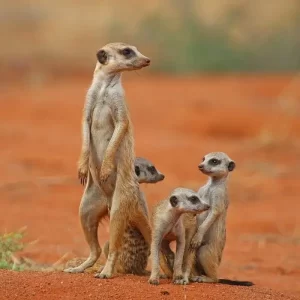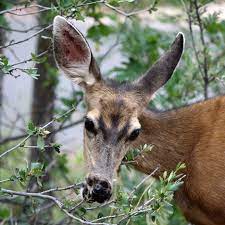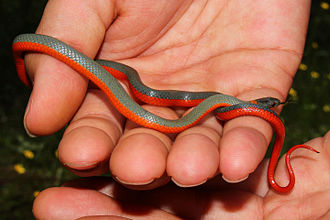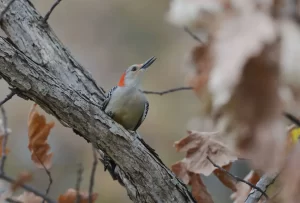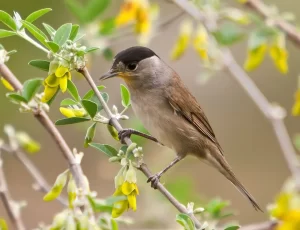Meerkats belong to the civet and mongoose family. Very small catlike carnivores, their faces often have a curious look, seemingly taking in everything in their surroundings. They have long bodies and short flat ears and are able to stand on their hind legs. The color of their coat can be gold, silver, brown, or orange, with dark patches around the eyes. They can dig their own bodyweight of dirt within a few seconds and their high endurance enables them to build elaborate tunnels. Their social cooperation within a large group and their extensively burrowed tunnels help them to survive in arid African deserts. Read this full article with PK Halder for gaining more knowledge about Meerkats.

Meerkat
Distribution
The meerkat has a wide distribution in southern Africa, from the extreme southwest of Angola, through Namibia and Botswana, and into the west and north South Africa.

Distribution
They live in areas with stony, often calcareous ground in a variety of arid, open habitats with little woody vegetation. Meerkats are common in savannahs, open plains, and rocky areas beside dry rivers. They are absent from true desert but may occur in semi-desert regions.
.
Habits and Lifestyle
The meerkat is like only three other mongoose species, in that it is highly sociable and inhabits
territories in packs. A pack usually has 10 to 30 individuals (although much larger ones are not uncommon where the food supply is plentiful) consisting of 3 or 4 family units with a male, female, and their young. Packs can move collectively in search of food, to escape high predator pressure and during floods.
Meerkats live in large burrow systems that are typically 5 m (16 ft) in diameter with around 15 openings; these large underground networks consist of 2 to 3 levels of tunnels. Once meerkats come out of their burrows in the early morning sun to sunbathe, most of them will go off to seek food while the others act as guards or babysit the young.

Meerkat habit
By standing on their hind legs up on mounds and in bushes, the guards are able to have a good view of approaching predators, particularly those in the sky. They will use different alarm calls to alert the group to the danger, and often the whole group will dive into the burrow to hide.
Diet and Nutrition
Meerkats are carnivores (insectivores), eating insects such as scorpions (they are immune to the venom), beetles, spiders, crickets, centipedes, millipedes, and worms. They also eat eggs, roots, tubers, small reptiles, and small mammals.
Mating Habits
Meerkats exhibit a monogamous mating system, meaning that the dominant male and female of each group are usually the only individuals to successfully breed. However, subordinate females very

baby-meerkat
occasionally will reproduce, and subordinate males will temporarily leave the group to try to mate with females of other groups, which suggests polygynous behavior.
The breeding season in the wild runs from October to April, whereas in captivity they breed year-round. Gestation lasts for 11 weeks, with 2 to 5 pups being born. The pups stay in their burrow for three weeks, ‘babysat’ by helpers. When they are four weeks old, the pups will begin to go with the group to forage, and for their first 49 to 63 days will be fed by the helpers, at the same time being taught how to get their own food. The young become independent enough to forage at around 12 weeks of age. This species becomes reproductively mature at about 1 year of age.
Population
Population threats
At present, there are no significant threats to the meerkat.
Population number

Meerkat population
According to the Natural History on the net resource, the total population size of the meerkat in the wild is around 500,000 individuals. Currently, this species is classified as Least Concern on the IUCN Red List and its numbers today remain stable.
Ecological niche
Meerkats have an important role in the food web, providing food for the animals that are their natural predators (hawks, eagles, jackals). They eat many invertebrates, and so probably act as a control on these prey populations.
Interactions with humans
Meerkats do pose a slight danger to humans. Meerkats are significant carriers of rabies. But there have only been ten documented cases of rabies-infected meerkats attacking people or domestic animals in the last ten years. They are also carriers of tick-borne diseases. On a more positive note they also help out humans. Meerkats may slow the increase of agricultural pest populations. Meerkats adapt well to captive settings and are a popular zoo exhibit animal. Meerkats are highly social and live in packs consisting of three familial groups. There can be up to thirty individuals in a pack. Each family group includes a breeding pair and their offspring. Meerkats exhibit behavior where one member of the group poses look out, watching for predators and other dangers. Older members of the group share their food with the younger meerkats. Predators include hawks, eagles, and jackals. Meerkats show a variety of anti-predator behaviors such as alarm calling, maintaining an alert stance, running for cover, defense threats, mobbing an enemy, self defense, and covering the young. In defense threats, meerkats appear larger than they really are. If a predator approaches in spite of the warnings, a meerkat will lie on its back with teeth and claws fully visible, protecting the back of its neck. For aerial predators, meerkats will flee to the burrow if an attack seems possible.
Importance of Meerkat
Meerkats are an important link in the food web because they provide food for predators. They also take many invertebrates, acting as a control on their own prey populations. Meerkat play closely mirrors real fighting but play doesn’t improve individual fighting skills. When a group feels like they are under attack they will stand together and act fiercely to scare the predator away. They could also dig quickly to stir up dust so they can hide. Like I previously stated in the habitat section, meerkats live with African ground squirrels or yellow mongoose in their burrows. This relationship is mutualistic because they can help each other dig burrows. Meerkats biggest predator would be raptorial birds. Meerkats have a matriarchal society which means that the mother is dominantly in charge. Also, female meerkats tend to be slightly larger than the male meerkats. Meerkat mobs spend their time grooming and playing together to keep the family as a tight unit. Meerkats are very territorial and will fight to defend their home from other meerkat mobs. To show this meerkat mobs have scent pouches and will rub these pouches on rocks and plants to mark their territory. Meerkat are food sources to eagles, hawks, snakes, and jackals. Meerkats eat many different types of insets, eggs, vegetable matter, and sometimes small mammals like rodents.
Facts
- The Honolulu Zoo keeps only male meerkats so that there is no possibility of escaped animals establishing a breeding population, which could cause serious damage to the natural ecosystem.
- A very keen sense of smell enables meerkats to locate prey, which they will dig out, using their long-clawed forefeet.
- A meerkat can move 50 times its body weight of sand and dig 400 holes in just half a day.
- The black patches around a meerkat’s eyes help protect it against the sun’s constant glare, rather like sunglasses for a human.
- Able to survive drinking no water, meerkats get the necessary moisture from eating tubers and roots, as well as fruit like tsama melons.
- When standing erect, a meerkat will balance on its long, stiff tail, using it as a kickstand for a bicycle.
- In the Disney film The Lion King, Timon was a meerkat.
- Young meerkats are so afraid of birds that airplanes will scare them into their burrows.
- As adaptations to living in a sandy habitat, meerkats are able to close their ears so that sand will stay out, and they also have a third eyelid that protects their eyes.

